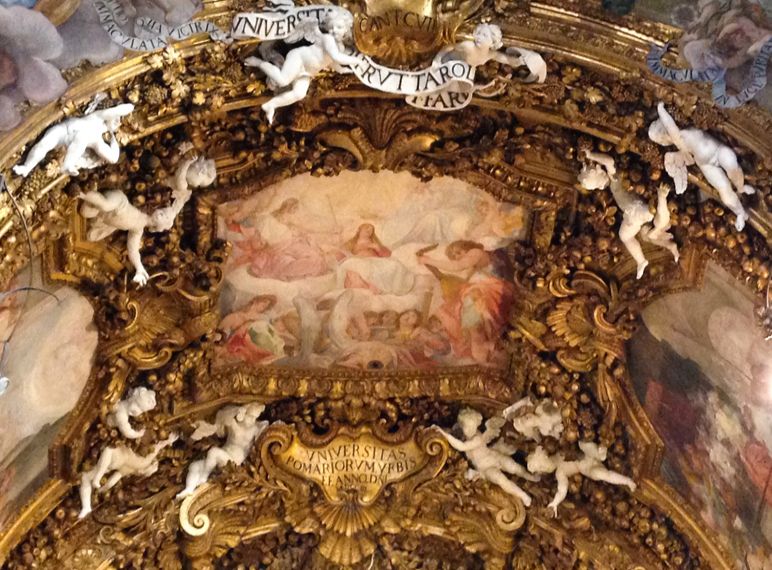Santa Maria dell'Orto
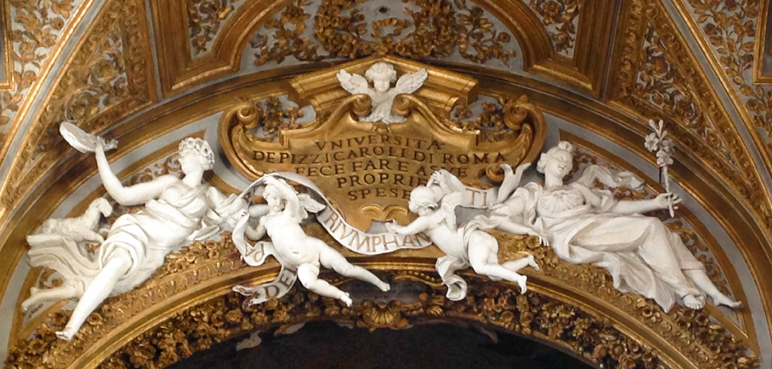
The church of Santa Maria dell'Orto owes its name ("orto" means vegetable garden) to its location, an area that was covered by vegetable gardens up to the end of the 15th century. According to the legend, a miracle was attributed to an image of the Virgin Mary painted on one of the border walls of a vegetable garden. The owner of this garden happened to be very sick and nothing could heal him. He prayed fervently the Madonna to intercede for him and when he fully recovered he ordered the building of a chapel dedicated to her as a sign of gratitude. A small group of faithful people soon gathered to worship the sacred image and eventually decided to call themselves the Compagnia della Madonna Santissima dell’Orto. In 1492 the Compagnia became a confraternity approved by pope Alexander VI. Almost one hundred years later, in 1588, it was elevated into an arch-confraternity aggregating several confraternities and was able to start the building of its own church.
The confraternity was a typical Italian association of people doing similar jobs or professions (mostly craftsmen and merchants) and helping each other. In the 15th century the confraternity of Santa Maria dell'Orto added up to twelve associations, among which were fruit and vegetable sellers, pizzicaroli (grocers), brokers of local trades, millers, vermicellari (craftsmen and resellers of pasta), sellers of chicken and cobblers.
They made it one of the richest confraternity in Rome and they were mostly foreigners.
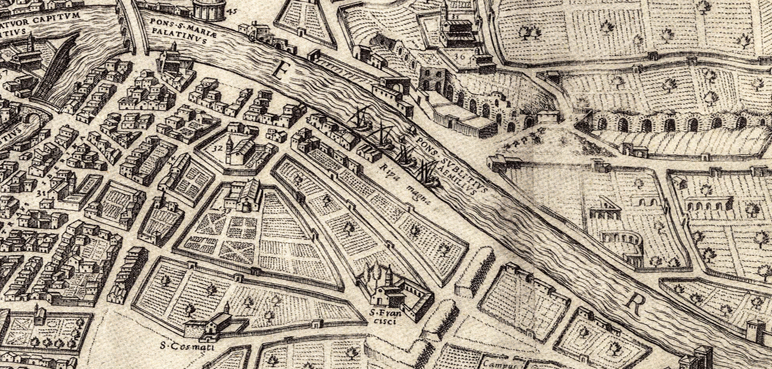
This area of Trastevere close to the Tiber river was known as the Port of Ripa Grande, a major commercial hub where commodities were carried to and from the port of Ostia by foreign ships. In addition, it was also close to the city walls and the Porta Portuense, (today's Porta Portese) a market place where farmers from the countryside wholesaled the food supply for the city of Rome.
At that time, it was essential to the life and business of people coming from foreign countries to establish strong relationships with the Roman economic and commercial environment. Therefore, in order to gain visibility and respectability, workers and professionals organized themselves in groups similar to the Medieval guilds. The association of different guilds was called confraternity (brotherhood). They had to be validated by a Pope and each of them had its own church.
Around the end of the 16th century, when the Confraternity of Santa Maria dell'Orto achieved the status of arch-confraternity with the concession of special privileges, the church became very relevant to them not only as a meeting place or a place of worship but because it was also the proper venue for them to exhibit their wealth and power.
Between the 17th and 18th centuries the arch-confraternity enjoyed the greatest prosperity and their church was completely restyled accordingly. Each association was responsible for the building, embellishment and maintenance of its own specific chapel and in fact they commissioned frescoes, paintings and sculptures as signs of their social relevance: a kind of competition that requested huge sums of money.
Today this beautiful church still bears witness of the associations' power and richness with its sumptuous gilded and white stucco decors, like the distinctive garlands of fruit and flowers.
Each association had also its own sepulcher in front of its chapel, as many brothers made generous donations in order to be buried inside their church and to have masses celebrated for their souls. You can see several decorated plaques on the floor remembering them.
Close to the adjacent oratory - a little baroque jewel - is a room whose walls are full of plaques with the names of individual donors inscribed.
The arch-confraternity was also used to employ the benefactors' money for charitable activities including the building of a 50 beds hospital for the members of the guild and their male relatives. It also built a pharmacy close to the church that reputedly was the best well-stocked in Rome at that time.
The hospital remained under the arch-confraternity until the mid-19th century. In 1870 however, the Italian unification brought about the loss of all their properties with the exception of the church.
Nowadays both the hospital and the pharmacy are private residences, but the arch-confraternity still exists and takes loving care of its wonderful church.

The Renaissance façade of the church was clearly visible from the Tiber until the 18th century, when the huge complex of the San Michele hospice was built. It's said that sailors on their ships crossing the Tiber used to look at the church and say a prayer to the Madonna.
Nowadays Santa Maria dell'Orto is not easy to find because it is surrounded by modern edifices such as a 19th-century school, a Bersaglieri barrack and an ugly 20th-century apartment building in the background.
The lower part of the façade was started by the great architect Vignola in 1566-68 while the upper section was completed between 1576 and 1577 by Francesco da Volterra. The upper order shows a tympanum sided by small curious travertine obelisks and a clock, both dating from the XVIII century.
If you pay attention to the clock you'll notice that it shows 6 hours instead of 12 and just one pointer. It's not working today, but 6 hour clocks were commonplace in Italy from the 15th to the 17th centuries. The so-called Italian hour has its origin in medieval times and in the monastic tradition of dividing the day according to prayer times. The pointer reached 6 at sunset and it was reset every two weeks in conformity with the sunset changes throughout the year. During the 15th century sunset was an important concept. In fact, with the fading of daylight farmers and other people stopped working and the gates in the ancient cities' walls were closed.
With the Napoleonic Wars in the 19th century the French introduced the Transalpine Time (called "Ore Oltramontane" in Italy) but Rome and the State of the Church adopted it some years later.
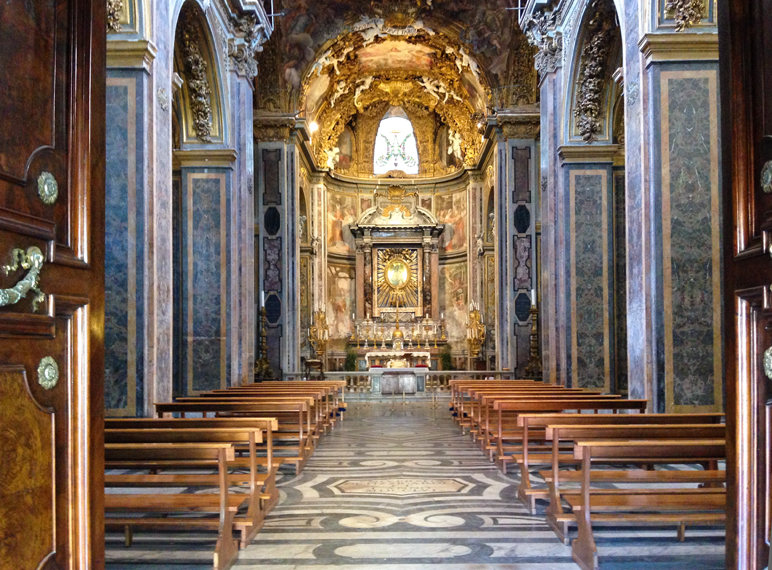
The gorgeous yet intimate interior with its luminous decor conveys an instant sense of joy.
The Latin-cross structure with a central nave and two aisles is the work of the architect Guidetto Guidetti, a pupil of Michelangelo.
The nave in the middle has a fresco painted by Giacinto Calandrucci in 1707. The frescoes in the apse are by the two Zuccari brothers (1556) and by Giovanni Baglione, painter and historian of the Roman Baroque.
The whole edifice is dedicated to the Madonna and several scholars maintain that the whole church is full of symbols related to the Holy Virgin.
The floor is also worth considering, as its polychrome marble intarsia has been designed and executed by the architect Gabriele Valvassori in the 18th century. A remarkable decoration is also to be seen below the transept, where the guild of fruit-sellers (Università de' Fruttaroli) has its floor epigraph in pietra dura work. It was the most prestigious association in the arch-confraternity and therefore was responsible for the high altar chapel.
The high altar is a Giacomo della Porta work, upon which is visible a portrait of the “Madonna col Bambino” from the middle XV century.
Since 2008 Santa Maria dell'Orto is the reference church of the Catholic Japanese community in Rome but the connection with Japan dates back to 1585, when the first Japanese Christian embassy came to Rome and visited the Pope. In order to celebrate the Christian delegation, Pope Sisto V arranged a feast consisting in a trip with ships beautifully adorned and musicians from the Port of Ripa Grande, right in front of Santa Maria dell'Orto, to the sea. Ancient chronicles report that a miracle occurred when a storm that threatened to wreck the ships came suddenly to an end thanks to the Japanese ambassadors' prayers to the holy image of Santa Maria dell'Orto.
Back in Japan, one of the ambassadors called Giuliano Nakaura became a priest and eventually suffered persecution and martyrdom. He was beatified in Nagasaki in 2008. Today a portrait of Nakaura is exposed in the church of Santa Maria dell'Orto and the miraculous event is remembered every year during the feast of the church on the third Sunday of October.
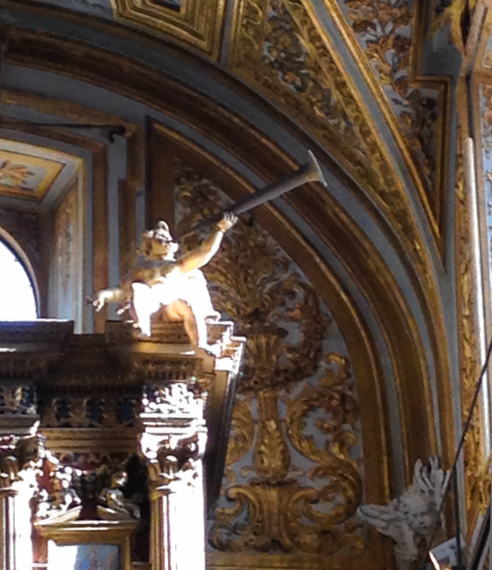
The third Sunday of October is the feast-day of Santa Maria dell'Orto and the church is adorned with fruit and vegetables. At the end of the mass apples are consecrated and given to those attending the ceremony.
Santa Maria dell'Orto is also well-known for its Macchina delle Quarantore, (Machine of the Forty Hours). It's a fine wooden structure realized in 1848 upon a 17-century design, a kind of gigantic candelabrum holding 213 candles which is installed before the high altar on Holy Thursday. It has its origin in a Medieval tradition, when the consecrated bread was put into a symbolic sepulcher from Holy Friday to Easter Sunday in remembrance of Christ lying 40 hours inside his sepulcher. With time this ceremony evolved into a devotional practice consisting in 40 hours of continuous prayer. The Eucharist was exposed on the main altar and its presence signaled by a special apparatus made of wood, papier-mâché decorations and chandeliers. Gian Lorenzo Bernini and other Baroque architects created several spectacular "Macchine delle Quarantore in order to attract the faithful into the churches and possibly to distract them from the excesses of the Carnival.
Santa Maria dell'Orto is the only church in Rome still displaying a Macchina delle Quarantore on the evening of Holy Thursday, when the ancient ceremony is revived by the members of the arch-confraternity who light all the 213 candles. On that special occasion the church remains open until Midnight. The Macchina is exposed inside the church for up to 50 days but unfortunately its candles are turned off.
A last curious fact worth noticing is that this gorgeous church has been often chosen as a cinematographic set, first of all by Roberto Rossellini for his film "Rome, Open City".
![]() +390658301874
+390658301874
![]() http://www.santamariadellorto.it/
http://www.santamariadellorto.it/
![]() 8.00 AM-12.00 AM; 4.00 PM-7 PM. Sundays and holidays only open in the morning. - Closed July and August. Mass is celebrated on Sundays and on the other feasts of precept at 11:00. Third Sunday of the month Mass is celebrated in Japanese (9.30 AM)
8.00 AM-12.00 AM; 4.00 PM-7 PM. Sundays and holidays only open in the morning. - Closed July and August. Mass is celebrated on Sundays and on the other feasts of precept at 11:00. Third Sunday of the month Mass is celebrated in Japanese (9.30 AM)
Via Anicia 10
